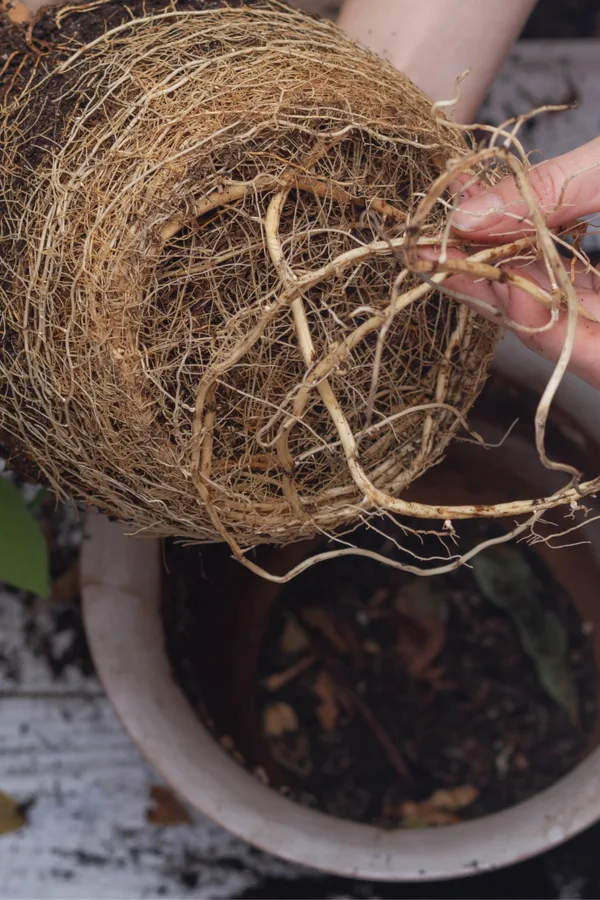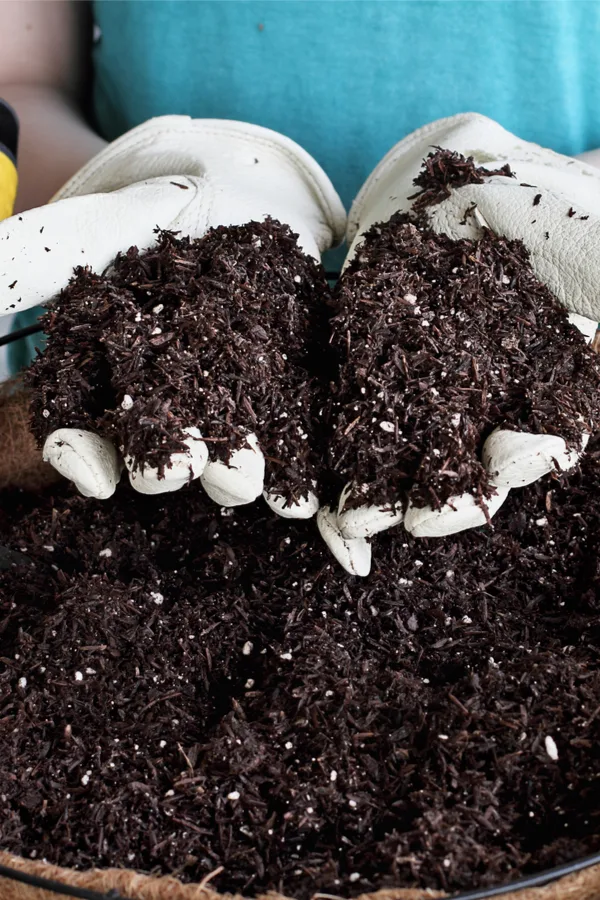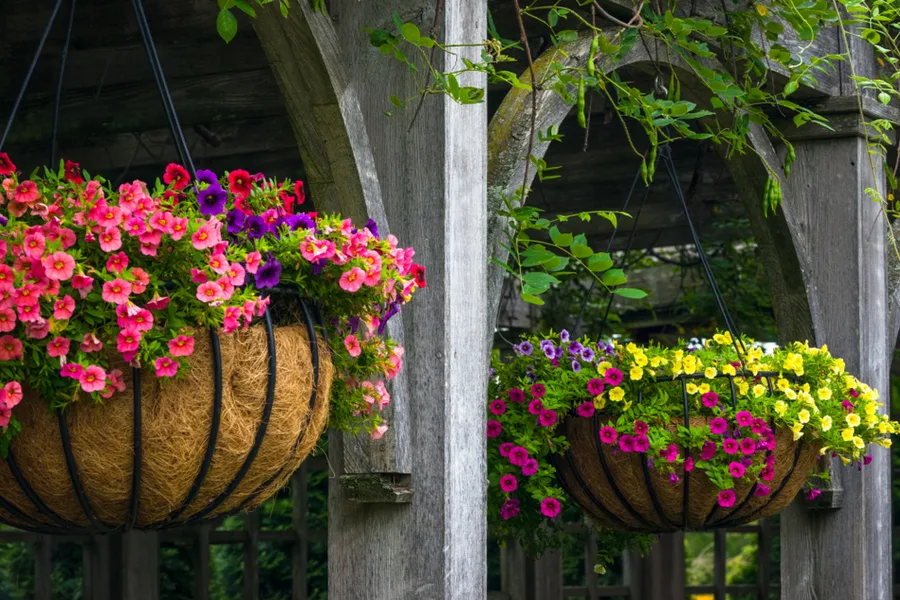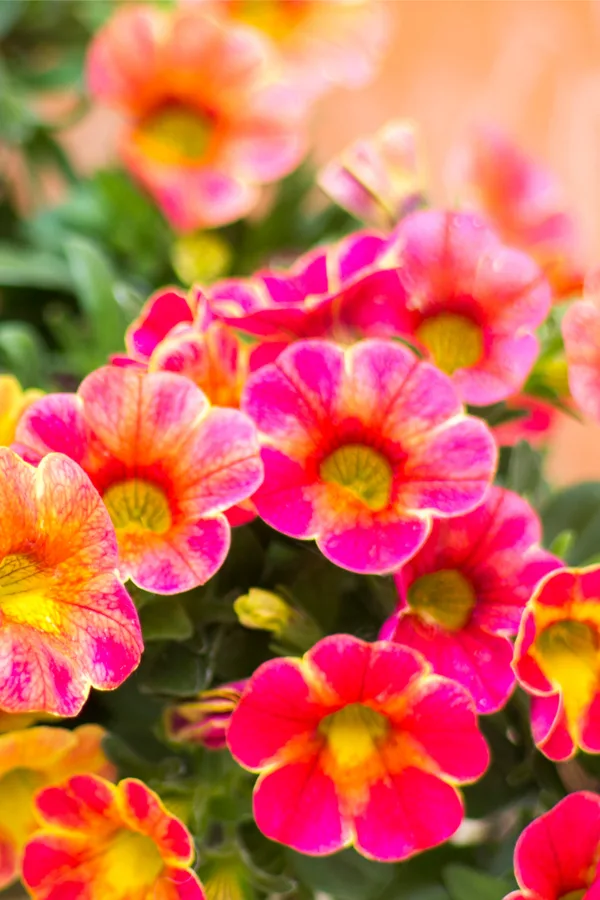Looking for a way to bring your struggling or overgrown hanging baskets back to life?
With hanging baskets costing as much as $50 or more depending on their size, simply throwing away an overgrown plant in mid-summer is not a very pleasing option for gardeners.
But unfortunately, as summer settles in, it can indeed start to spell the end of the line for many hanging baskets. What were once thick, luscious plants full of flowers often begin to morph into a tangled mess of brittle foliage and blooms that are few and far between.

Even giving your baskets a drink at this point can turn into an adventure. You know this if you have ever had to dodge the torrent of water as it pours through the bottom of the basket as soon as you water from the top!
We’ve all been there. Watching the life of our once-proud flowering baskets slowly drain away in mid-summer. This occurrence is almost always a direct result of the roots of your hanging basket plants simply running out of room – and available nutrients from the soil.
Dealing With Overgrown Hanging Baskets
Most commercial hanging basket plants are planted indoors in December or January. This is done to give them plenty of time to grow and flower before the big spring garden rush to stores.
It certainly makes for beautiful baskets for display. And most of those baskets will still stay strong into May and even June. But as summer hits full stride, many begin to show the tell-tale signs of running out of room and energy.
And even for those who plant their own baskets, if the planting basket isn’t big enough, roots can run out of room quickly too. As roots become crowded, and the soil loses all of its available nutrients, flowering plants will begin to fail.

Shortly after that, the foliage begins to show signs of suffering too. For awhile, a bit of fertilizer and proper watering can keep the plant going. But in the end, once a plant becomes root bound, no amount of watering or fertilizing is going to save it.
In fact, it’s nearly impossible to water or fertilize the plant at this point. The moisture and nutrients simply run right through the container every time you try to apply them!
What To Do With Overgrown Hanging Baskets
The good news is that you can revive root bound plants for a second life. And even better, it can be easier than you think. The real key to success is to act fast.
The longer a plant stays in a root bound state, the less chance it will have to survive. If the stems begin to shrivel and too much foliage begins to fall from the plant, it can often be too late.
One thing is for sure, the minute your hanging basket plants begin to drain through water, it’s time to jump into action!
To revive your plants, you have two options. The first, and the most obvious, is to replant your hanging baskets into a larger container. This is certainly a great option if your plants happen to be in a smaller container. Again, the key to success is acting fast, before the plant suffers to much.

Repotting – How To Replant Overgrow Hanging Baskets
When repotting, it is extremely important to select the right size container for your plant. Always try to select a pot that is at least 25% larger than your current hanging basket.
If at all possible, go even larger. A hanging basket pot that is double the size is even better, but understandably, it can be hard to find baskets big enough if your hanging plant is already in a large container.
By selecting a basket at least 1/4 of a size larger, you will allow enough room for the plant’s roots to grow strong until the end of the season. Now that you have your new basket selected, it’s time for re-potting it! To do this, you will need three very important materials:
- Fertile Potting Soil
- Granular Fertilizer or Worm Castings
- Liquid Fertilizer
For starters, a rich, loose, fertile potting soil is a must. In order to get the cramped roots to expand, the soil must be loose. And because the plants are in need of new energy, having fertile soil will help them absorb nutrients quickly. See: How To Create The Best Potting Soil For Your Potted Plants

As for the two types of fertilizer, they are important for helping the plant to recover quickly. After all, remember, your plant’s roots have been smashed up in the container and unable to take in nutrients for some time. Getting them fed fast is a big key to getting them to bounce back!
The Repotting Process – How To Replant Overgrow Hanging Baskets
To repot for success, start by mixing in even more power to your potting soil. If you are using worm castings, mix in 1/2 cup of castings for every 2 cups of potting soil.
Worm castings are an excellent choice, as not only do they add power, they also are incredible for holding moisture. That can be a big help when trying to revive a hanging basket. Product Link: Pure Worm Castings
You can also use an all-purpose, store-bought granular fertilizer in place of castings. A fertilizer in the range of 5-5-5 to 10-10-10 will work best for this. Mix into the soil at a rate of 1/4 cup of fertilizer for every 3 cups of potting soil.
Repotting
Start by filling the bottom of your new basket with the soil/castings or soil/fertilizer mix. Next, remove your root-bound plant from its current container. This process is usually quite simple as the overgrown root mass will slide out with little effort.

Before placing into the soil in the new basket, gently loosen the tangled roots. Do this on the bottom and the sides. This process will most likely break a few roots, but the plant can handle this. More than anything else, you are just trying to allow the roots a chance to spread into the new soil.
The new plant should rest just below the top of the new container. Fill in around the sides with the potting soil mix, gently packing the soil around the roots. Do not overpack the soil – but make sure it is firm in the basket.
Now it is time to give it an additional boost with a liquid fertilizer. Liquid fertilizers are fast acting, and will plump up the plant quickly. Since it is a mature plant at this point, there is no worry of overpowering it.
Using compost tea or a store-bought liquid fertilizer, give the plant a good soaking of nutrients. In about a week, give the plant one more dose to help it recover. Thereafter, continue on with your regular fertilizing schedule as you would with your other annual container plants.
Replanting Overgrown Hanging Baskets Into Flowerbeds
So what about replanting hanging basket plants that were already in large containers? One thing is for sure, it can be quite the challenge finding baskets large enough for replanting big baskets. And even if you can, they are most likely going to be way too heavy to hang!
If your flowering basket is already large, your best bet to save the plant is to simply plant it directly into your flowerbeds or landscape.
A massive flowering basket can add huge color and interest wherever it grows. And by planting it directly into the soil, you can solve the nutrient and water issues in a flash.

Dig your planting hole to twice the size of the diameter of your baskets, and about one and a half times as deep. Fill the bottom of your planting hole with potting soil or compost. Again, this will allow the roots to expand quickly.
Break apart the root ball to help the roots expand faster. Next, plant into the soil, once again adding in a bit of worm castings or granular fertilizer as you do. When replanting around the edges, mix in a bit more compost or potting soil with the regular soil to help the roots grow into the soil.
Give It A Boost! – How To Replant Overgrow Hanging Baskets
Finally, just as with repotting, water the plant well, and give it a good dose of a liquid fertilizer to douse the soil and foliage. Just as with repotting, it will help to power up the plant quickly, and get your plant back up and blooming big in a flash!
Here is to repotting your overgrown hanging baskets and extending their life!
Follow Our Facebook Page For Great Gardening Tips And Advice! This Is My Garden Facebook Page
This Is My Garden is a garden website created by gardeners, for gardeners. Jim and Mary Competti have been writing gardening, DIY and recipe articles and books and speaking for over 15 years from their 46 acre Ohio farm. They publish three articles every week, 52 weeks a year. Sign up today to follow via email, or follow along!

